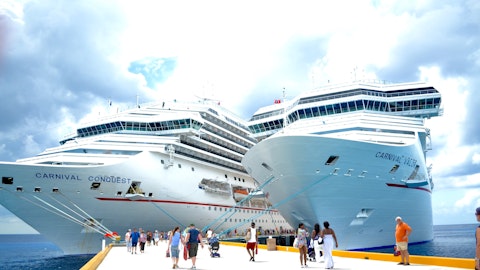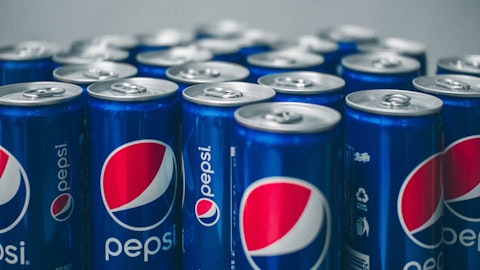In this article, we discuss 5 best FMCG stocks to buy now. If you want our detailed analysis of these stocks, go directly to 12 Best FMCG Stocks To Buy Now.
5. Dollar General Corporation (NYSE:DG)
Number of Hedge Fund holders: 53
Dollar General Corporation (NYSE:DG) is the largest discount retailer in the United States. The company operates nearly 18,000 stores in 46 states and plans to open ten stores in Mexico by the end of FY2022. During Q1 2022, the company’s cash flow was recorded at around $168 million and repurchased shares worth $747 million. Dollar General Corporation (NYSE:DG) also paid $125 million in dividends in the same quarter.
Between 2011 and 2021, Dollar General Corporation (NYSE:DG)’s revenue surged from $14.8 billion to $34.2 billion with a compound annual growth rate of 9%. Furthermore, during the same period, the net income displayed a CAGR of 12% from $767 million in 2011 to $2.4 billion in 2021. On top of that, Dollar General Corporation (NYSE:DG)’s stock grew by nearly 360% in the last decade.
In the first quarter of 2022, hedge funds showed a positive sentiment towards Dollar General Corporation (NYSE:DG). Out of the 912 hedge funds tracked by Insider Monkey, 53 had a stake in the company compared to 44 in the previous quarter.
Here is what LRT Capital Management has to say about Dollar General Corporation (NYSE:DG) in its Q3 2021 investor letter:
“Executive Summary
At LRT Capital Management we are continuously searching the market for great investment opportunities. Our favorite finds are companies with moats and growth opportunities that justify a higher price than what the stock is trading for. One of our holdings (approximately 1.5% of our long exposure) is Dollar General (DG), so today, we wanted to tell you a bit about this great company.
Company Overview
Dollar General is a discount retailer with the largest brick-and-mortar presence in the United States by store count. The company’s largest concentration of stores can be found in the southern, southwestern, midwestern, and eastern parts of the United States.10 Dollar General was founded in 1939 by J.L. Turner, who originally named the company “J.L. Turner and Son, Wholesale”. As the name suggests, the company began its life as a wholesaler, but quickly turned to a retailer of general store goods. By the early 1950s, the company had annual sales of $2 million per year,12 which is the equivalent of $22.95 million in 2021 dollars when adjusted for inflation.
The first Dollar General store opened on June 1st, 1955 in Springfield Kentucky. The simple concept was that no item in the store would cost more than one dollar. The company changed its name to Dollar General Corporation in 1968 when Dollar General became publicly traded. At the time of its initial public offering, the business generated more than $40 million in annual sales. The company’s common stock was publicly traded from 1968 until July 2007, when it was taken private by KKR. The company went public again in November 2009, under the ticker DG.
Today, Dollar General is an evolved, and phenomenal business with more room for growth. Annual sales reached a record $33.7 billion in fiscal year 2021 after consecutively growing the top line for many years. The company’s main products are every-day necessities and consumables purchased by lower income consumers on tight budgets…”
4. Costco Wholesale Corporation (NASDAQ:COST)
Number of Holders: 61
Costco Wholesale Corporation (NASDAQ:COST) is an American multinational corporation and one of the largest retailers in the world. The company operates a chain of membership-only retail stores. Historically, the membership fees have procured more than 60% of the company’s operating profit and Costco Wholesale Corporation (NASDAQ:COST)’s membership renewal rate is over 90%.
On July 14, Deutsche Bank analyst Krisztina Katai upgraded Costco Wholesale Corporation (NASDAQ:COST)’s shares from Hold to Buy and assigned a price target of $579, up from $525. According to the analyst, the company “is one of the most consistent operators in our group, and its steady traffic gains and high membership renewal rates serve as key differentiators in an increasingly uncertain backdrop”. Furthermore, the analyst noted that Costco Wholesale Corporation (NASDAQ:COST) is expected to increase its membership fee, which the company has not done since 2017.
As of the first quarter of 2022, 61 hedge funds made Costco Wholesale Corporation (NASDAQ:COST) a part of their portfolio, compared to 57 in the prior quarter. Fisher Asset Management was the most prominent stakeholder in the company at the end of Q1, with shares worth $2.4 billion.
Here is what ClearBridge Investments had to say about Costco Wholesale Corporation (NASDAQ:COST) in its Q4 2021 investor letter:
“Portfolio gains were led by a diverse group of contributors. Also in consumer discretionary, Costco, which operates a chain of membership-only big-box retail stores, continues to impress as it takes to share and becomes more relevant for the consumer even as the world opens up.”
3. PepsiCo, Inc. (NASDAQ:PEP)
Number of Hedge Fund Holders: 62
PepsiCo, Inc. (NASDAQ:PEP) is a multinational food, snacks, and beverage company that operates in more than 200 countries. The company has 23 brands with over $1 billion in sales.
PepsiCo, Inc. (NASDAQ:PEP) has recorded a revenue CAGR of 8.78% in the last two years. In addition, the company reported revenues of $80.85 billion in the last twelve months, in addition to gross margins of 53.4%. This exhibits a sales increase of 20.3% compared to the pre-pandemic levels. In the last twelve months, PepsiCo, Inc. (NASDAQ:PEP) reported an income of $10.17 billion, constituting an increase of 39.1% from pre-pandemic levels. Lastly, the company reported a free cash flow of $7.39 billion in the last twelve months, an increase of 38.1% compared to FY 2019 levels.
On July 7, Morgan Stanley analyst Dara Mohsenian stated that he is optimistic about PepsiCo, Inc. (NASDAQ:PEP) and believes that the company will post “solid” Q2 sales. The analyst considers the company’s revenue growth to be “sustainably above what’s priced in by the market”. Mohsenian maintained an Overweight rating on the company’s shares with a price target of $198.
ClearBridge Investments mentioned PepsiCo, Inc. (NASDAQ:PEP) in its Q4, 2021 investor letter. Here is what the firm said:
“The pandemic created opportunities for us to be more aggressive in a variety of areas of the market. We were opportunistic throughout the year. After a strong year for equities, we sought to bolster more defensive areas of the portfolio and added to PepsiCo, increasing our exposure to a high-quality and stable name.”
2. The Procter & Gamble Company (NYSE:PG)
Number of Hedge Fund Holders:72
The Procter & Gamble Company (NYSE:PG) is an Ohio-based consumer goods company. The company has been paying dividends for the last 132 years and increasing them for the last 6.5 decades. It is expected that the company will have paid $18 billion in dividends by the end of 2022. At the end of the first quarter of 2022, 72 hedge funds were bullish on the company, compared to 67 in the previous quarter.
For the first quarter of 2022, The Procter & Gamble Company (NYSE:PG) posted an EPS of $1.33, outperforming the estimates of $1.29. The recorded revenue was $19.98 billion, exceeding the forecasts by $633.71 million. Moreover, for FY 2022, the organic sales growth of The Procter & Gamble Company (NYSE:PG) was recorded at 4%, 6%, and 10% for the first, second, and third quarters respectively.
On June 21, Deutsche Bank analyst Steve Powers maintained a Buy rating on The Procter & Gamble Company (NYSE:PG)’s shares with a price target of $157, down from $171 after Deutsche’s consumer conference in Paris. According to Morgan Stanley, The Procter & Gamble Company (NYSE:PG) is one of the 15 stocks that can weather a bear market. The factors considered were quality, free cash flow, free cash flow yield, and analyst ratings.
1. Johnson & Johnson (NYSE:JNJ)
Number of Hedge Fund Holders: 83
Johnson & Johnson (NYSE:JNJ) is an American multinational corporation and one of the most valued companies in the world. The company provides medical devices, pharmaceuticals, and consumer goods. The company has a AAA credit rating which is not only suitable for the company but also its shareholders.
In 2021, Johnson & Johnson (NYSE:JNJ) made 147 innovation deals, 20 new equity investments, and 3 acquisitions and licensing agreements. The company’s most recent expansion step was acquiring Texas and Oklahoma wholesale brokerage & binding assets and managing general underwriting units from Midlands Management Corporation in April. It is a massive step towards the growth and acceleration of the company.
Johnson & Johnson (NYSE:JNJ) is a dividend king that has increased its dividend for nearly 60 years. On April 19, the company announced its latest increase in its quarterly dividend to $1.13. The current yield is 2.54% with an annual payout of $4.52.
On June 22, Daiwa initiated coverage of Johnson & Johnson (NYSE:JNJ) with a $180 price target and an Outperform rating on its shares.
As of the first quarter of 2022, 83 hedge funds held stakes in Johnson & Johnson (NYSE:JNJ), with Arrow Street Capital being the investor with the highest stake. The fund increased its holdings in the company by 38% to $1.179 billion. Furthermore, the hedge fund with the second-highest stake was GQG Partners, followed by Bridgewater Associates. The former increased its holding in Johnson & Johnson (NYSE:JNJ) by 65%, while the latter increased it by 41% in Q1 2022.
You can also take a peek at 10 Best Buy-The-Dip Consumer Stocks to Consider and The 10 Best Monthly Dividend Stocks to Buy in July.





